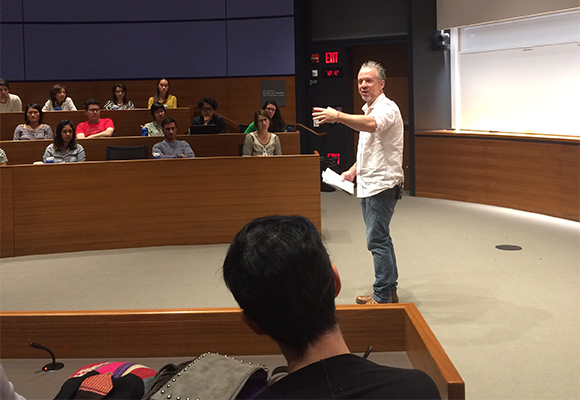
Persuading Through Storytelling
The image of the young girl in a red dress behind the glass is forever burned into Rob Morris’s memory.
She sat among a row of others just like her in a brothel, expressionless—distinguished by a glint of life in her eyes and the number she wore pinned to her dress: 146. That is how Morris will always remember her.
“It was probably the most disturbing moment of my life: I had to pretend to be the monster I was trying to stop,” Morris told students at Yale SOM on September 10. “You realize something needs to be done about this.”

At the time, Morris was part of an undercover investigation that aimed to break up a sex-trafficking operation in Southeast Asia. The experience led him to dedicate his life to stopping and preventing modern-day slavery through Love146, an international human rights organization headquartered in New Haven.
Morris, the president and co-founder of Love146, spoke as part of the Superpowers of Influence workshop, organized by Professor Zoë Chance, which brings individuals from a variety of sectors to Yale SOM to share practical guidance on how to influence and persuade people.
For Morris, storytelling is key to his work’s success. People aren’t persuaded to act by statistics and numbers about how many children have been affected, he said; it’s the human element that engages them.
“People hear those statistics and they forget them. What they don’t forget is when you tell them a story,” Morris said. “The individual attachment allows you to get beyond the ‘Oh my God, this is a horrible thing’ and become attached to the cause.”
Morris said that making the personal connection is key, even when the subject matter can be difficult for most to hear or learn about. He told students a story about the feelings he felt as a parent as he worked to rehabilitate children in the sex trade and find safe homes for them to stay in, and another about the opportunity he had to celebrate the wedding day of one of the girls who had gone through the Love146 recovery program as a youth and now has a family of her own.
“If you can find yourself in the story, there’s a way that connects you to it that becomes different and more a part of it,” he said. “You’re not just telling good or bad stories for the sake of telling them; you’re telling the reality of people’s lives.”



